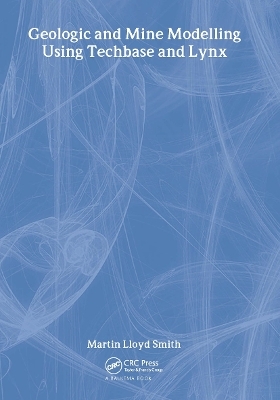
Geologic and Mine Modelling Using Techbase and Lynx
A A Balkema Publishers (Verlag)
978-90-5410-692-0 (ISBN)
- Titel z.Zt. nicht lieferbar
- Versandkostenfrei
- Auch auf Rechnung
- Artikel merken
Martin Smith (Author)
PREFACE -- 1 INTRODUCTION -- 1.1 Geologic and mine modelling software -- 1.2 Modelling as a basis for decision making and design -- 1.3 Overview and limits of geologic and mine modelling -- 1.4 Geologic and mine modelling procedure -- 1.5 Examples and conventions used in text -- 1.6 An introduction to Techbase -- 1.6.1 Overview of Techbase -- 1.6.2 Limitations of Techbase -- 1.6.3 Navigating Techbase -- 1.7 An introduction to Lynx -- 1.7.1 Overview of Lynx -- 1.7.2 Limitations of Lynx -- 1.7.3 Navigating Lynx -- 1.8 A comparison of Techbase and Lynx -- 2 GEOLOGIC DATABASE MANAGEMENT -- 2.1 Data formats -- 2.1.1 Survey or map data -- 2.1.2 Drillhole data -- 2.2 Geologic database structure -- 2.3 Creating a Techbase database -- 2.4 Key fields and join tables -- 2.5 Creating a Lynx database -- 2.5.1 Type 1: Header records -- 2.5.2 Type 1: Survey records -- 2.5.3 Type 1: Data records -- 2.6 Some hints on UNIX, text editing and generating Lynx ASCII drillhole data files -- 2.7 Working with map data -- 2.8 Lynx map definition -- 2.9 Importing ASCII map data -- 3 DATA ANALYSIS -- 3.1 Introduction -- 3.1.1 Data validation -- 3.1.2 Exploratory analysis -- 3.1.3 Outliers and population classes -- 3.1.4 Distributions -- 3.1.5 Correlations -- 3.1.6 Spatial covariance -- 3.2 Visual data analysis -- 3.2.1 Scatter plots -- 3.2.2 Histograms -- 3.2.3 Contour maps -- 3.3 Spatial covariance -- 3.4 Drift and trend surfaces -- 4 MODELLING GEOLOGIC SURFACES -- 4.1 Drillhole data compositing -- 4.1.1 Regularization -- 4.1.2 Boundary intercepts -- 4.1.3 Compositing methods -- 4.2 Two-dimensional surface modelling -- 4.3 Representing a surface as a matrix -- 4.4 Cell tables in Techbase -- 4.5 Triangulated surfaces -- 4.6 Calculating volumes from triangle sets -- 4.7 Interactive geological interpretation -- 4.8 Cross sectional displays -- 4.9 Interactive geological interpretation and volume modelling -- 5 ESTIMATION OF GRIDS, AREAS AND VOLUMES OF INTERSECTION -- 5.1 Estimation methods -- 5.2 Areas of influence -- 5.3 Triangles and triangulation -- 5.4 Splines -- 5.5 Weighted averages and inverse distance -- 5.6 Block models -- 5.7 Geologic reserves -- 5.8 Derivation of the Kriging weights -- 5.9 Derivation of an expression for R(x0) -- 5.10 Unconstrained optimization of a single function and the Lagrange parameter -- 5.11 Deriving the Kriging system of equations -- 5.12 Modelling the experimental variogram -- 5.12.1 Nugget effect -- 5.12.2 Linear models -- 5.12.3 Spherical models -- 5.12.4 Exponential models -- 5.12.5 Gaussian models -- 5.12.6 Hole effect -- 5.13 Modelling anisotropic variograms -- 5.14 Using jackknifing to evaluate estimation accuracy -- 5.15 Estimating areas and volumes of intersection -- 6 OPEN PIT MINE DESIGN -- 6.1 Geological versus mining block models -- 6.2 Intersecting pits, block models and surface topography -- 6.3 Calculating mining block values -- 6.4 Pit expansion methods -- 6.5 Cone mining heuristics -- 6.6 Ultimate pit limit optimization -- 6.7 Pit expansion -- 6.8 Including haul roads in an expanded pit -- 6.9 Haul road construction in plan view -- 6.10 Pit volume modelling and mining reserve analysis -- 7 UNDERGROUND DESIGN -- 7.1 Mine development openings -- 7.2 Mine access and haulage method -- 7.3 Shaft location and number -- 7.4 Shaft design -- 7.5 Shaft station chambers -- 7.6 Level intervals -- 7.7 Raises -- 7.8 Ramps -- 7.9 Drifts and crosscuts -- 7.10 Using Lynx for underground excavation design -- 7.11 Mine excavation openings -- 7.12 Stope design using Lynx -- 7.13 Using Techbase for underground excavation design -- 7.14 Polygon tables -- 8 PRODUCTION SCHEDULING -- 8.1 Long-term production scheduling -- 8.2 Short-term production scheduling -- APPENDIX 1: Project databases A1.1 Using the project databases -- A1.1.1 Suggestions for using Techbase databases A1.1.2 Suggestions for using Lynx databases -- A1.2 Project descriptions Al.2.1 Boland Banya A 1.2.2 Smoot Al.2.3 Pasir A 1.2.4 Tutorial -- APPENDIX 2: Techbase database automatic fields -- APPENDIX 3: Techbase value settings -- REFERENCES -- INDEX.
| Erscheint lt. Verlag | 1.1.1999 |
|---|---|
| Verlagsort | Rotterdam |
| Sprache | englisch |
| Maße | 178 x 254 mm |
| Gewicht | 771 g |
| Themenwelt | Mathematik / Informatik ► Informatik ► Theorie / Studium |
| Technik ► Bauwesen | |
| Technik ► Bergbau | |
| ISBN-10 | 90-5410-692-1 / 9054106921 |
| ISBN-13 | 978-90-5410-692-0 / 9789054106920 |
| Zustand | Neuware |
| Informationen gemäß Produktsicherheitsverordnung (GPSR) | |
| Haben Sie eine Frage zum Produkt? |
aus dem Bereich


